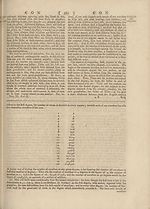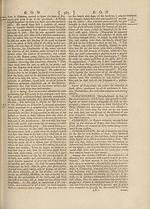Encyclopaedia Britannica, or, a Dictionary of arts, sciences, and miscellaneous literature : enlarged and improved. Illustrated with nearly six hundred engravings > Volume 6, CHI-Crystallization
(608) Page 562
Download files
Complete book:
Individual page:
Thumbnail gallery: Grid view | List view

CON [ s6_2
Confangui- King Henry VII. who flaw Richird III. in the battle
c iUty‘ , of Bofworth, was related to that prince in the fifth
degree Let the prapofuus, therefore, in the table of
confanguinity, reprefent King Richard III. and the
clafs marked E, King Henry VII. Now their com¬
mon flock or anceftor was King Edward III. the aba-
vus in the fame table : from him to Edmund duke of
York, the prcavus, is one degree ; to Richard earl of
Cambridge, the avus, two j to Richard duke of York,
the pater, three j to King Richard III. the propojitus,
four 5 and from King Edward III. to John of Gaunt
(a) is one degree ; to John earl of Somerfet (b) two ;
to John duke of Somerfet (c) three; to Margaret
countefs of Richmond (d) four; to King Henry VII,
(e) five. Which lad-mentioned prince, being the far-
thed removed from the common dock, gives the deno¬
mination to the degree of kindred in the canon and
municipal law. Though according to the computation
of the civilians (who count upwards from either of the
perfons related, to the common dock, and then down¬
wards again to the other $ reckoning a degree for each
perfon both afeending and defeending) thefe two
princes were related in the ninth degree: for from
King Richard III. to Richard duke of York is one
degree j to Richard earl of Cambridge two j to Ed¬
mund duke of York three j to King Edward III. the
] CON
common ancedor, four •, to John of Gaunt five; to ConfanjJ
John earl of Somerfet fix; to John duke of Somerfet [
feven ; to Margaret couMefs of Richmond eight j to ^0Rfc‘en(|
King Henry VII. nine. Seethe Table of Confangui-W"v'‘
nity (Plate CLXIV.), wherein all the degrees of col¬
lateral kindred to the propojitus are computed, as far
as the tenth of the civilians and the feventh of the ca-
nonids inclufive 5 the former being diftinguifhed by the
numeral letters, the latter by the common ciphers.
Consanguinity and Jjjfinity, degrees of, forbidden
in marriage. See P^arriage and Law Index.
Consanguinity and Affinity, an objeftion againft
a judge or a witnefs. See Law Index.
CONSCIENCE, a fecret tedimony of the foul,
whereby it gives its approbation to things that are j
naturally good, and condemns thofe that are evil. See
Moral Philosophy.
A man of integrity wall never liden to any reafon, or
give way to any meafnre, or be mided by any induce¬
ment, againft confcience.—The inhabitants of a great
town offered Mardial de Turenne 100,000 crowns,
upon condition he would take another road, and not
march his troops their way. He anfwered them, “ As
your town is not in the road I intend to march, I
cannot accept the money you offer me.”-—The earl
of Derby, in the reign of Edward III. making a de-
feent
ancedors has two defeendants who increafe in a duplicate ratio, it will follow, that the ratio in which all the
defeendants increafe downwards, mud be double to that in which the ancedors increafe upwards : but we have
feen, that the ancedors increafe in a duplicate ratio : therefore, the defeendants mud; increafe in a double duplicate j
that is, in quadruple ratio.
Collateral Degrees. Number of Kindred.
2
3
4
5
6
7
8
9
10
11
12
*3
14
*5
16
17
18
*9
20
4
16
64
256
1024
4096
16384
65536
262144
1048576
4194304
16777216
67108864
268435456
io7374i824
4294967296
17179869184
68719476736
274877906944
This calculation may alfo be formed by a more compendious procefs, viz. by fquaring the couples, or half
the number of ancedors, at any given degree j which will furnifti us with the number of kindred we have in
the fame degree, at equal didance with ourfelves from the common dock, befides thofe at unequal dtdances.
Thus in the tenth lineal degree, he number of ancedors is 1024; its half, or the couples, amounts to 512; the
number of kindred in the tenth collateral degree amounts therefor* to 262144, or the fquare of 512. And, if
we will be at the trouble to recollefl the date of the feveral familie* within our own knowledge, and obferve how
far they agree with this account j that is, whether, on an average, every man has not one brother or fider, four
firft-coufins, fixteen fecond coufins, and fo on, we (hall find, that the prefent calculation is very far from being
overcharged
Confangui- King Henry VII. who flaw Richird III. in the battle
c iUty‘ , of Bofworth, was related to that prince in the fifth
degree Let the prapofuus, therefore, in the table of
confanguinity, reprefent King Richard III. and the
clafs marked E, King Henry VII. Now their com¬
mon flock or anceftor was King Edward III. the aba-
vus in the fame table : from him to Edmund duke of
York, the prcavus, is one degree ; to Richard earl of
Cambridge, the avus, two j to Richard duke of York,
the pater, three j to King Richard III. the propojitus,
four 5 and from King Edward III. to John of Gaunt
(a) is one degree ; to John earl of Somerfet (b) two ;
to John duke of Somerfet (c) three; to Margaret
countefs of Richmond (d) four; to King Henry VII,
(e) five. Which lad-mentioned prince, being the far-
thed removed from the common dock, gives the deno¬
mination to the degree of kindred in the canon and
municipal law. Though according to the computation
of the civilians (who count upwards from either of the
perfons related, to the common dock, and then down¬
wards again to the other $ reckoning a degree for each
perfon both afeending and defeending) thefe two
princes were related in the ninth degree: for from
King Richard III. to Richard duke of York is one
degree j to Richard earl of Cambridge two j to Ed¬
mund duke of York three j to King Edward III. the
] CON
common ancedor, four •, to John of Gaunt five; to ConfanjJ
John earl of Somerfet fix; to John duke of Somerfet [
feven ; to Margaret couMefs of Richmond eight j to ^0Rfc‘en(|
King Henry VII. nine. Seethe Table of Confangui-W"v'‘
nity (Plate CLXIV.), wherein all the degrees of col¬
lateral kindred to the propojitus are computed, as far
as the tenth of the civilians and the feventh of the ca-
nonids inclufive 5 the former being diftinguifhed by the
numeral letters, the latter by the common ciphers.
Consanguinity and Jjjfinity, degrees of, forbidden
in marriage. See P^arriage and Law Index.
Consanguinity and Affinity, an objeftion againft
a judge or a witnefs. See Law Index.
CONSCIENCE, a fecret tedimony of the foul,
whereby it gives its approbation to things that are j
naturally good, and condemns thofe that are evil. See
Moral Philosophy.
A man of integrity wall never liden to any reafon, or
give way to any meafnre, or be mided by any induce¬
ment, againft confcience.—The inhabitants of a great
town offered Mardial de Turenne 100,000 crowns,
upon condition he would take another road, and not
march his troops their way. He anfwered them, “ As
your town is not in the road I intend to march, I
cannot accept the money you offer me.”-—The earl
of Derby, in the reign of Edward III. making a de-
feent
ancedors has two defeendants who increafe in a duplicate ratio, it will follow, that the ratio in which all the
defeendants increafe downwards, mud be double to that in which the ancedors increafe upwards : but we have
feen, that the ancedors increafe in a duplicate ratio : therefore, the defeendants mud; increafe in a double duplicate j
that is, in quadruple ratio.
Collateral Degrees. Number of Kindred.
2
3
4
5
6
7
8
9
10
11
12
*3
14
*5
16
17
18
*9
20
4
16
64
256
1024
4096
16384
65536
262144
1048576
4194304
16777216
67108864
268435456
io7374i824
4294967296
17179869184
68719476736
274877906944
This calculation may alfo be formed by a more compendious procefs, viz. by fquaring the couples, or half
the number of ancedors, at any given degree j which will furnifti us with the number of kindred we have in
the fame degree, at equal didance with ourfelves from the common dock, befides thofe at unequal dtdances.
Thus in the tenth lineal degree, he number of ancedors is 1024; its half, or the couples, amounts to 512; the
number of kindred in the tenth collateral degree amounts therefor* to 262144, or the fquare of 512. And, if
we will be at the trouble to recollefl the date of the feveral familie* within our own knowledge, and obferve how
far they agree with this account j that is, whether, on an average, every man has not one brother or fider, four
firft-coufins, fixteen fecond coufins, and fo on, we (hall find, that the prefent calculation is very far from being
overcharged
Set display mode to:
![]() Universal Viewer |
Universal Viewer | ![]() Mirador |
Large image | Transcription
Mirador |
Large image | Transcription
Images and transcriptions on this page, including medium image downloads, may be used under the Creative Commons Attribution 4.0 International Licence unless otherwise stated. ![]()
| Permanent URL | https://digital.nls.uk/193015327 |
|---|
| Attribution and copyright: |
|
|---|
| Description | Ten editions of 'Encyclopaedia Britannica', issued from 1768-1903, in 231 volumes. Originally issued in 100 weekly parts (3 volumes) between 1768 and 1771 by publishers: Colin Macfarquhar and Andrew Bell (Edinburgh); editor: William Smellie: engraver: Andrew Bell. Expanded editions in the 19th century featured more volumes and contributions from leading experts in their fields. Managed and published in Edinburgh up to the 9th edition (25 volumes, from 1875-1889); the 10th edition (1902-1903) re-issued the 9th edition, with 11 supplementary volumes. |
|---|---|
| Additional NLS resources: |
|

